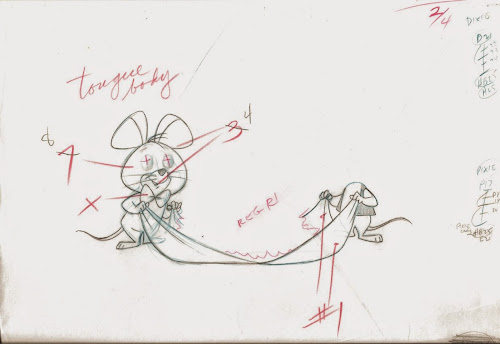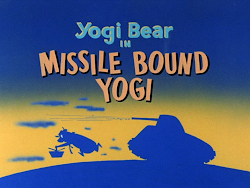Loopy De Loop cartoons are full of concepts that Hanna-Barbera did far better earlier, but a few of them contain little gems.
The final Loopy cartoon released by Columbia in the 1964-65 theatrical season was “Big Mouse Take.” It’s different in that Loopy doesn’t show up for the first third of the cartoon, so during that time it seems like you’ve somehow tuned in to some lost H-B TV series from 50 years ago. The second thing I thought watching it was “Hey, that’s Carlo Vinci!” Chatterly the cat shows up on screen in a tail-pumping, awkward-looking run cycle that could only have come from Carlo’s mind. And the cat has a diving exit off screen just like Carlo animated at Terrytoons and in the early H-B cartoons of the late ‘50s.
But then something happened in the cartoon that caused me to stop it, download it, and study it frame-by-frame. Hanna-Barbera characters weren’t known for their big takes in 1965—how can you exaggerate Atom Ant, after all?—but Chatterly pulled off one in this cartoon. And you can’t credit Carlo this time.
The situation is something so warped only Mike Maltese could have come up with it. After a chase inside a home, Chatterly swallows Bigelow the mouse, who becomes stuck inside the end of the cat’s tail. Chatterly tries to evict Bigelow by putting his tail out the window and slamming down the sash. But that means he’s also slammed it down on his tail and he lets out a huge scream. Look at these great drawings.
![]()
![]()
![]()
![]()
These fun drawings aren’t the work of Carlo Vinci. I believe it was helpful Howard Fein who mentioned once that the stretched-head was an animation quirk of Hugh Fraser, the former Disney artist who teamed up with Carlo on “The Flintstones” and “The Jetsons,” and pointed to the same sort of thing in the “Miss Solar System” episode. In fact, I found the same head stretch in an episode of the TV Popeyes he animated/directed in 1960.
Fraser began, like many other H-B artists, working for Walt Disney and went back as far as “Snow White.” He ended up working for former Disney director Jack Kinney at his own studio before moving to Hanna-Barbera for a long career. He animated (with former Disneyites Ed Aardal, Ed Parks and Harvey Toombs) on the first episode of “Jonny Quest.” Fraser died on January 6, 1994 at the age of 89.
Oh, the first thing I thought watching this cartoon? “Daws is re-using Fibber Fox’s voice.” Some aspects of the earliest Hanna-Barbera series were derivations of something else, but the studio began to copy itself, and the copies were never as good as the original. Loopy De Loop himself is an example. The idea of a pleasant guy with an accent who gets bashed around then talks at the camera came from Huckleberry Hound (and the Carolinian Huck had far more charm than Loopy and his Québécois dialect). There’s even a version of the “ran-out-of-piddies/finger” gag pulled by Tweety Bird that is tired and pale by comparison. And, in this case, the cartoon co-stars Bigelow the mouse whom the cat afraid of because he’s...Bigelow? I shrug.
At least the short has a few, very brief shining moments thanks to guys who had worked at Disney and Terrytoons, two studios at the opposite ends of the cartoon quality scale.
Here’s one of Carlo’s run cycles for the great-named Chatterly. I’ve slowed it down. The baseboard jerks a bit because the background drawings don’t match up between the last frame and when the first repeats again.
The final Loopy cartoon released by Columbia in the 1964-65 theatrical season was “Big Mouse Take.” It’s different in that Loopy doesn’t show up for the first third of the cartoon, so during that time it seems like you’ve somehow tuned in to some lost H-B TV series from 50 years ago. The second thing I thought watching it was “Hey, that’s Carlo Vinci!” Chatterly the cat shows up on screen in a tail-pumping, awkward-looking run cycle that could only have come from Carlo’s mind. And the cat has a diving exit off screen just like Carlo animated at Terrytoons and in the early H-B cartoons of the late ‘50s.
But then something happened in the cartoon that caused me to stop it, download it, and study it frame-by-frame. Hanna-Barbera characters weren’t known for their big takes in 1965—how can you exaggerate Atom Ant, after all?—but Chatterly pulled off one in this cartoon. And you can’t credit Carlo this time.
The situation is something so warped only Mike Maltese could have come up with it. After a chase inside a home, Chatterly swallows Bigelow the mouse, who becomes stuck inside the end of the cat’s tail. Chatterly tries to evict Bigelow by putting his tail out the window and slamming down the sash. But that means he’s also slammed it down on his tail and he lets out a huge scream. Look at these great drawings.




These fun drawings aren’t the work of Carlo Vinci. I believe it was helpful Howard Fein who mentioned once that the stretched-head was an animation quirk of Hugh Fraser, the former Disney artist who teamed up with Carlo on “The Flintstones” and “The Jetsons,” and pointed to the same sort of thing in the “Miss Solar System” episode. In fact, I found the same head stretch in an episode of the TV Popeyes he animated/directed in 1960.
Fraser began, like many other H-B artists, working for Walt Disney and went back as far as “Snow White.” He ended up working for former Disney director Jack Kinney at his own studio before moving to Hanna-Barbera for a long career. He animated (with former Disneyites Ed Aardal, Ed Parks and Harvey Toombs) on the first episode of “Jonny Quest.” Fraser died on January 6, 1994 at the age of 89.
Oh, the first thing I thought watching this cartoon? “Daws is re-using Fibber Fox’s voice.” Some aspects of the earliest Hanna-Barbera series were derivations of something else, but the studio began to copy itself, and the copies were never as good as the original. Loopy De Loop himself is an example. The idea of a pleasant guy with an accent who gets bashed around then talks at the camera came from Huckleberry Hound (and the Carolinian Huck had far more charm than Loopy and his Québécois dialect). There’s even a version of the “ran-out-of-piddies/finger” gag pulled by Tweety Bird that is tired and pale by comparison. And, in this case, the cartoon co-stars Bigelow the mouse whom the cat afraid of because he’s...Bigelow? I shrug.
At least the short has a few, very brief shining moments thanks to guys who had worked at Disney and Terrytoons, two studios at the opposite ends of the cartoon quality scale.
Here’s one of Carlo’s run cycles for the great-named Chatterly. I’ve slowed it down. The baseboard jerks a bit because the background drawings don’t match up between the last frame and when the first repeats again.

P.S.: If I had just bothered to check the credits before writing this post, I would have seen that Carlo Vinci and Hugh Fraser animated the cartoon.












































































































.png)



















































